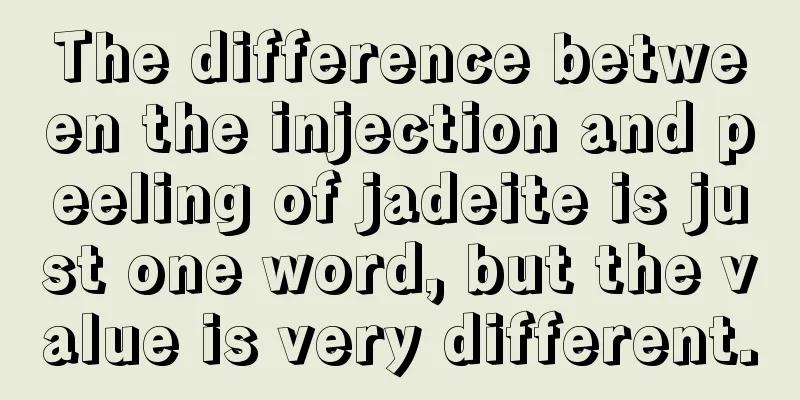The difference between the injection and peeling of jadeite is just one word, but the value is very different.

|
Jadeite glueiness means that when light shines on jadeite, it looks like a piece of solidified glue. When it rotates under the light, it looks like a flowing colloid. It has a strong transparent structure and light perception. In fact, not all natural A-grade jadeite can be glued. It must meet the following conditions: 1. It is of ice grade or above, old grade, and has very fine grains. 2. The internal crystal particles are not arranged in a directional manner. 3. The entire piece of jade is free of impurities. Natural Jade Glue injection is one of the most commonly used processing techniques for B-grade and C-grade jadeite. Jade that has been washed with strong acid has a loose structure, so the cracks will be filled with glue before further processing. With the improvement of craftsmanship, the polished glue-injected jadeite looks not much different from natural A-grade jadeite, which is quite confusing. Glue-injected jadeite Identification of Glue-Injected Jadeite: color The color distribution of B-grade jadeite has no sense of hierarchy. After soaking in acidic solution, the base turns white and the green color becomes more floating, which looks very unnatural. Cement Since the original fissures are concave and have obvious grooves, the filling is obviously lower than the two sides. Cementation or residual bubbles can be seen in larger "trenches". Gloss changes After being soaked in strong acid and alkali, jade becomes loose in structure and its luster weakens. After adding organic fillers such as resin or plastic, jade often has resin luster, waxy luster, or a mixture of glass luster with resin luster and waxy luster. Nowadays, many non-natural jades are not only processed by injecting glue, but also dyed or injected with colored glue to enhance the quality and color of the jade. Information on the NGTC certificate According to data feedback from appraisal agencies, jadeite is a popular category for inspection at jewelry exhibitions, but the detection rate of processed jadeite is also relatively high, such as bleaching, wax dipping, filling treatment (B goods), "dyeing + bleaching + filling" treatment (B+C), dyeing treatment (C goods), etc. Note the markings in the remarks column Therefore, when purchasing jade, you must not be careless. If you are not sure whether the jade is natural, conducting necessary tests is the best way to protect yourself.
fcgc33 fcpf18 |
<<: What are the 10 most common colors of jade?
>>: How well do jade and cheongsam match? Perfect match!
Recommend
The carving determines the value of your jade!
In a piece of jadeite, what factors do you think ...
What is the "hidden" in jadeite collection?
With the booming development of the jade market a...
Why does jade need to be inlaid? What is the role of inlay?
Jade inlay is a skill that requires very high tec...
The process of carving a Buddha's Heart plaque from a piece of floating flower jadeite
The process from a piece of material to a finishe...
Detailed explanation of jadeite colors, don’t think that only green jadeite is valuable!
As we all know, in addition to its quality, color...
What are the 7 "Qualities" of Jadeite?
Jade has always been regarded as a treasure by pe...
Are you tempted by these reasons for investing in jewelry?
As the old saying goes, gold is hidden in trouble...
I bought a jadeite for 230,000 yuan and it can be returned immediately. What do you think?
Not long ago, a woman went to Yunnan for a trip a...
Why do stone veins appear on jade? Is jadeite with stone veins worthless?
In the human body, tendons refer to ligaments att...
How to identify A-grade jadeite bracelets? A-grade jadeite is natural
Jadeite, also known as jadeite jade, jadeite, jad...
How can you choose the jade leaves that suit your needs?
There are many kinds of jade pendants, among whic...
Isn’t jadeite jade? What is the difference between jadeite and jade?
Jadeite is a type of jade, but jade includes a wi...
What does it mean to have jade and emerald? ——Basic interpretation of jadeite
The word "jade" has been mentioned so m...
Turning waste into treasure, bringing the dead back to life, a magical profession that brings countless wonderful works
There is a saying in the jade carving industry: &...
The production and processing process of jadeite, from jadeite raw stone to finished product
Although jade has the highest market value, it is...









